Cradle
- Tom Haukaas, Lakota, American, 1950-
- Born: Florida
- Work Locations: Florida
Born in 1950 and raised in Florida, Tom Haukaas is a contemporary artist of Lakota and Puerto Rican heritage. In addition to being an artist, he trained as a medical doctor.
Haukaas did not have formal art training, but he grew up admiring his Lakota grandmother’s beadwork. He traces the beginning of his education in Native arts to his attempt to make his own traditional attire when he wanted to learn Sioux dances.
While studying medicine at the University of Colorado-Denver, Haukaas made many trips to the American Indian galleries at the Denver Art Museum and took a course with the museum’s curator of Native arts at the time, Richard Conn. Cradle was made specifically for the Museum’s collection and grew out of discussions Haukaas had with Conn about the nature of contemporary art and its relationship to Native arts. Haukaas was especially intrigued by the work of Frank Stella, an artist who created sculptural paintings on aluminum in the 1970s, and he applied this concept when creating Cradle, using beads instead of paint. Haukaas calls the cradle an opportunity to explore the “false dichotomy between sculpture and painting.”
The cradle form is traditional among Plains Indians but lost popularity during the last century as Indians assimilated to white culture. Haukaas found Lakota elders to show him how to construct Cradle. The beadwork images tell the Lakota creation story, as described in the "Details" section.
Details

Seed Beads
Haukaas used extraordinarily small seed beads to decorate this cradle. Seed beads were introduced to Plains artists around 1855 and offered a larger variety of colors than previously available, which led to the development of new styles of beadwork.
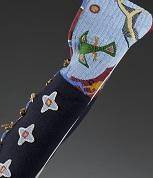
Soft Sculpture
By “painting” the cradle on all sides with beads, Haukaas blurs the line between sculpture and painting. He thinks of the cradle as a soft sculpture meant to be displayed in the round and seen from all sides.

Balanced Design
The six stars on the front of the cradle help balance the light color of the hood and the dark color of the body. The animals on the hood (horses and birds) are arranged symmetrically on either side of the central human figure and the celestial bodies (moon, sun, and morning star) are also symmetrically placed.
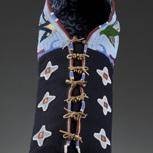
Lakota Creation Story
“The design [for this cradle] is our creation story, when we are transformed into a human body after leaving behind a sacred place, time, and form,” Haukaas said (to Nancy Blomberg, Curator of Native Arts, DAM). In the Lakota creation story, the Buffalo Nation, or Pte Oyate, lived inside caves in South Dakota’s Black Hills until Iktomi the spider fooled them into coming to the surface world. As they ascended they assumed human form.
Haukaas illustrates this story moving from the back to the front of Cradle.
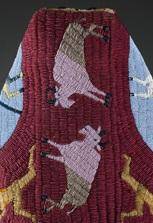
Lakota Creation Story: Backside
The back of the cradle shows the Buffalo Nation (represented by two buffalo figures) living inside the caves of the Black Hills, as well as figures making the buffalo-to-human transformation.
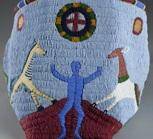
Lakota Creation Story: Hood
On the hood of Cradle, a human, flanked by two horses, emerges from the Black Hills. Above this figure are the sun, moon, and morning star—the three celestial bodies that “lord over” this world.
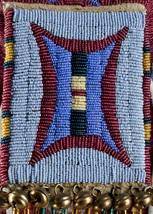
Lakota Creation Story: Iktomi
Haukaas uses an old geometric symbol for Iktomi, the trickster spider, on the top tab.
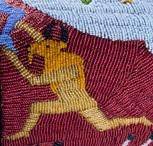
Lakota Creation Story: Transformation Figures
The buffalo-to-human transformation figures are Haukaas’s own invention. With no Lakota precedent to draw on, he looked at examples from other cultures, including ancient Greece. People should know that American Indian artists draw inspiration from many different cultures, Haukaas once said.
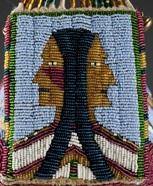
Lakota Creation Story: Agon-ite
As part of his research, Haukaas discovered that some Lakota believe that Anog-ite, or Double-faced Woman, was involved in the creation of the Lakota people. Although this is not a predominant viewpoint, Haukaas includes his own invented rendition of Anog-ite in Cradle. He incorporates it in a place hidden from view (on the underside of the tab at the top of the Cradle) so that the figure is present but also symbolically removed from the main story.
More Resources
Websites
Jewelry Making Magazine: A Fierce Loyalty
Read about another of Tom Haukaas’ beaded cradles, The Ultimate Container for Praise and Polemics, in this article from Bead and Button Magazine featuring a Kiowa bead artist.
Books
McFadden, David & Ellen Taubman. Changing Hands: Art without Reservation 2: Contemporary Native North American Art from the West, Northwest and Pacific. Museum of Art & Design: New York, NY. 2005.
Read Tom Haukaas’ article “2 Be(ad) or Not 2 Be(ad)” about the history of beading among Plains artists and contemporary beadwork in this book on Native art.
Funding for object education resources provided by a grant from the Morgridge Family Foundation. Additional funding provided by the William Randolph Hearst Endowment for Education Programs, and Xcel Energy Foundation. We thank our colleagues at the University of Denver Morgridge College of Education.
The images on this page are intended for classroom use only and may not be reproduced for other reasons without the permission of the Denver Art Museum. This object may not currently be on display at the museum.
